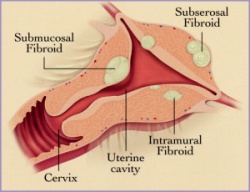|
||
Fibroids |
WHAT ARE FIBROIDS?
 The womb (uterus) forms part of the female reproductive system. the inside lining of the womb is called the endometrium and the outer wall is made up of a thick layer of muscle call the myometrium. It is within this muscle wall that uterine fibroids can form. Uterine fibroids are small lumps or growths that grow bigger very slowly, usually over a few yeas, but may eventually cause problems, They are known as “benign” (not cancer) and do not lead to cancer of the uterus or ovaries. Fibroids can be quite small but can grow larger to become about the size of a small plum.
The womb (uterus) forms part of the female reproductive system. the inside lining of the womb is called the endometrium and the outer wall is made up of a thick layer of muscle call the myometrium. It is within this muscle wall that uterine fibroids can form. Uterine fibroids are small lumps or growths that grow bigger very slowly, usually over a few yeas, but may eventually cause problems, They are known as “benign” (not cancer) and do not lead to cancer of the uterus or ovaries. Fibroids can be quite small but can grow larger to become about the size of a small plum.
ARE FIBROIDS COMMON?
Fibroids are the most common condition affecting a woman’s reproductive system. It is difficult to say exactly how many women have fibroids as they do not always cause problems, or symptoms - even though they may be quite big. As many as one in five of all women under 50 are thought to have fibroids and they are more common in women around the age of 40. They are also seen more in women of Afro-Caribbean origin and in women who have never been pregnant.
WHAT CAUSES FIBROIDS?
It is not known what causes fibroids but they do stop growing and actually shrink after menopause. This means that they grow in response to a hormone produced by your ovaries called oestrogen. After the menopause your ovaries no longer produce oestrogen in large amounts and the fibroids no longer grow. Fibroids also tend to grow during pregnancy when your body has a lot of oestrogen, although they do not usually cause the mother or baby any serious problems. Fibroids are more likely to develop if you have a family history of this condition, but you cannot “catch” them or prevent their development.
WHAT ARE THE SYMPTOMS?
Many women do not have any symptoms and do not even know they have fibroids until their doctor discovers them during a routine examination. When symptoms do occur they often begin as feelings of discomfort, bloating and heaviness. Some women suffer with very heavy periods especially if they have the fibroids that have grown inside the cavity of their womb. The period becomes heavier on the 2nd and 3rd day often with “flooding” (soaking of tampons or sanitary towels), blood clots and pain. Heavy periods can lead to a condition of the blood called anaemia which tends to make you feel very tired and lethargic. Fibroids do not generally cause pain but some women may suffer with low backache or “crampy” abdominal pains. If fibroids grow quite large they may press onto other organs nearby such as the bladder or bowel causing problems with urination or constipation. Fibroids may be associated with infertility and may be the cause of infertility in up to 10% of cases.
WHAT SHOULD I DO IF I THINK I HAVE FIBROIDS?
If you have any of the symptoms described you should see your doctor. It is important that you obtain help and advice on how to relieve your symptoms.
DOWNLOAD
|
|||
©2003 - 2011 Dr Paul Fogarty
